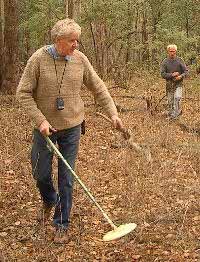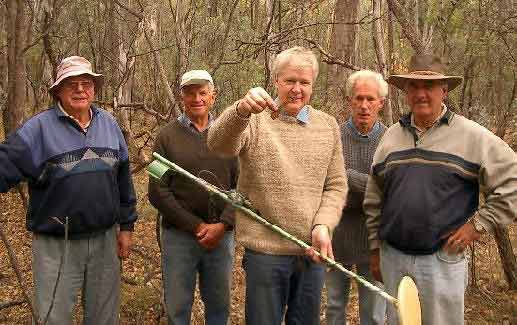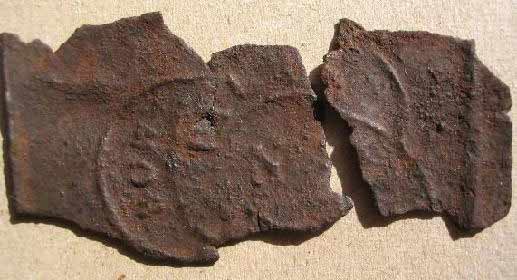The hut behind the school
at Bobinawarrah, N. E Victoria. story Bill Denheld.
There have been several references made to abodes occupied by the Kelly
gang while they were on the run. This story concerns another 'hut'.
A
definite place the gang occupied between February 1879 to June 1880.
Known
as the 'hut behind the school', it was in fact 4 miles away behind the
school and almost
impossible to find by the authorities because it could be only easily
reached by entering through private property ( as is still the case
today).
 |
I became interested after receiving some pictures from a descendant of
Tom Lloyd, fifth gang member. This hut it was said had been occupied
by the Kelly gang and the question was, 'where had' this hut been located?
|
Also by the looks, the hut must have been important to the owners to have
it preserved this way. The picture first surfaced around forty plus years
ago.
If you happen to know anything about the above picture please let us know.
Please note the picture is reserved copy right.
It all started recently, I was contacted by friend Kelly
researcher
Marcus Swinburne about a hut near
Bobinawarrah (near Milawa NE Victoria), and I thought the picture above may be the same hut but this has proven
to be negative. For one, ' the hut behind the school' was described as a bark
hut, and burnt to the ground during 1880. It was on crown land and I then ask
why would someone go to the trouble to build a roof over it. Clearly this
hut pictured was a pioneer hut of importance to a family and as well as having
been the living quarters for the Kelly gang, making this image very
interesting.
Marcus had searched a likely area with fellow researcher Bruce Johnson
without success. Their inquiries led to other local historians who while
in the process of
writing his family history, discovered that his Great uncle was James
Wallace. Wallace had actually been a Kelly sympathiser and heavily implicated with the gang while
they
occupied the hut behind the school. The author is Arthur Hall. I wondered
if he was related to G Wilson Hall, the Kelly sympathiser newspaper
proprietor who wrote 'The Outlaws of the Wombat Ranges' ? or a Mr. Henry
Hall who had married Anges Hart sister of Steve Hart? ( we are still to
get answers to these questions)
Arthur Hall's book 'James Wallace' (1854 -1910) The
Head Master of Hurdle Creek school, was co written and researched by
Julie Stevens.
In the book there is reference
that Wallace helped the Kelly gang occupy the hut behind the school.
Wallace fell foul with the law for helping fellow
countrymen and good friend
Joe Byrne and the gang. Joe needed his help and James decided as a consequence to have one foot in
the Kelly camp and an other as police informer, but actually he was doing
the direct opposite, he was a double agent. In this way, he believed his family
was safe and assured protection either way.
James Wallace was helping the gang with provisions and shelter
while he was head master. His wife Barbara was also Post
mistress in the little enclave of Bobinawarrah, and they were able to watch all
the goings on to help their friend Joe Byrne. About six months after the
capture of the Kelly gang a concerted effort was mounted to arrest all
people who may have been sympathetic or assisted the gang, and Wallace was
a prime target. Someone had told the police of the hut occupied by ' the
gang' and a search party did finally find it. A few days later the
police investigators had returned to investigate the site to see if they
could find out who the occupants had been.
As quoted from Arthur Hall's book, this passage is recorded in a police
file on Wallace at the Public Records Office
- Quote-
" On reaching the spot they found the hut burned to the ground, and the
tins, bottles, and similar debris totally destroyed, so as to prevent the
possibility of identification. The destruction had been caused, the
Detectives thought, by a bush fire ----- but an examination of the place
showed that the fire had commenced a little below the hut on the rise, and
the flames having done their work soon after passing over the spot where
the hut stood. Regret was expressed by several, upon becoming acquainted
with the fact that the Police in the first instance had not taken
precaution to preserve the empty tins and bottles, seen in and around the
hut, inasmuch as the identity of the purchasers might thereby have been
traced".
This hut had been built by wood splitters early 1870's and
contained four bunks.
Situated on crown land, the local land owners could not be charged with
harboring the fugitives, but great care by the gang members not to take
horses to their hut ensured no one could follow the tracks back to
camp.
When Marcus asked Arthur Hall if he knew where the hut had stood he said,
mate, I have been trying to find it for thirty years, you cannot expect to
find it with a once off attempt? As it happened, Arthur had followed an
important lead but ended up in the wrong arm of the creek. A clue came from another
local, Mr. Duncan McCallum 81 years old whose father had long ago said he
had seen the ground left bare left by the fire after the hut was destroyed. Another clue came from the report that the
hut was situated near a freshwater spring, and Duncan knew where that spring
was. This was the coming together of an important historical
investigation.
On 22 April 2006 we all assembled at Moyhu for the walk in .
From Left to
Right: 1 Bruce Johnson, 2. Arthur Hall, 3. Alan Gibb* 4. Ray McAliece,
5.
Marcus Swinburne, 6. David Hurley, 7. Duncan McCallum, 8. Stuart McAliece,
9. Bill Denheld and 10. Graham Gibb* ( Dook).

The hope was
to
locate the hut site at the 'spring' in the dry rocky creek. The
spring had been located some weeks previous but no hut site could be
identified.
The hut site location can only be reached through private property and the
walk in was led by *Alan Gibb. Marcus with back pack is fifth from left.
 |
 |
A quick detect around a wide area
proved the ground was very clean of signals. ( No rubbish ) When a signal was found we knew it was significant and had hit a jackpot. |
With my trusty old
Garrett, our expedition was to prove successful with the
detection of hand forged nails and the remains of an old large kitchen knife blade.
All
agreed this was significant as belonging to a domestically occupied hut there.

Duncan McCallum, Stuart McAliece, Bill Denheld, David Hurley and Ray McAliece
During the next short while enough items were found to outline the hut
footprint on the ground. The knife, although almost completely rusted away
still reveals the handle tang shape, but it may have been a cutlery carving fork
because the metal is thick both sides near the tang.

Below,
The following week *David Harris and Brian Read had a detect there and
found more items that weren't dug up during the first detect.

The most exciting find must be this part that looks like a gun trigger.

If someone can identify this part we would sure like to know about it.
There is clearly a pivot point (left) suggesting a trigger lever action
and a spring point close to the finger end. This part was found near
where a nail had been dug up the previous week.
Some other items un earthed include a three cornered file.

 |
Left,
we see the waterhole that made living here possible. This is the only
water for miles around. The hut had stood on the high bank not far
from this natural spring. All wild life would frequent this spot daily
offering the Kelly gang fresh meat and water. |

As more of this story develops- it will be posted here. All items found are
held in trust for the day they can be displayed at the Ned Kelly Centre
Glenrowan.
It was recorded that James Wallace supplied lots of tinned food to the
gang.
Also found at the site was a complete vintage sardine tin still with
a soldered seal in the jagged peeled back top. The tin fragment below reads H A M
if seen from the other side. Can anyone identify this ham logo for dating ?

Further works to follow -
The book by
Arthur Hall and Julie Stevens 'James Wallace', The head master of Hurdle
Creek (State School ) A review to follow. For copies email
me,-
Bill Denheld and I will put you in touch with the authors.
James Whitty and Ned Kelly, by Marcus Swinburne.
Settlers of the Oxley Plains - the
Swinburne's , the Wallace's,
McAliece,
Gibb and other players in the Kelly outbrteak.
* David Harris. wrote - " I have long had
an interest in the Kelly story.
My great great grandparents on my mother's side were Eliza and Henry
Mutton who apparently leased land to Red ( John) Kelly when they were at
Avenel.
Their gravestone stands under a tree in a paddock on the east side of the
freeway between just south of Avenel."
** ( brothers ) Alan and Graham Gibb
Kindly gave permission to show this exclusive image of Jim Kelly.
 Note
from their friend David Harris -
reads
Note
from their friend David Harris -
reads
" On the 7th February 2004 Cath Gibb of
Bobinawarrah, told me how in 1942 she nursed James Kelly at St Mary's
Hospital Green St Wangaratta.
When James was
discharged Cath asked him if she could take a photo of him (with a box
brownie) in the hospital garden, James was in his eighties by that time".
This is that photo she took of Jim Kelly.
Thank you to Cath, Alan and Graham Gibb and all who took part in this most
interesting story. We, the website readers are all the richer and grateful
for your generosity. Bill Denheld
Further reading about James Wallace-
There is a wonderfully informative article from The
Age dated 10 June 1882 about James Wallace, the Schoolmaster and goes into
details about the burnt hut and about his alleged connections to the Kelly
gang. Followed by Wallace's letter to the editor published 14 June 1882 where he
defends himself and refutes some of The Age statements.
http://www.denheldid.com/twohuts/wallacelettersbobinawarrahut.htm
All
contents and images on this website are copyright reserved.
Not to be
reproduced without express permission.
Bill Denheld
20 May 2006
Back ground image is of the Kelly camp at Kelly
Creek circa 1883


